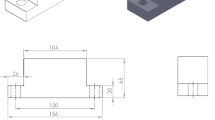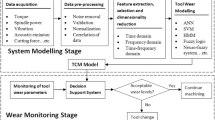Abstract
A new method is proposed to improve cutter life and cutting efficiency of five-axis plunge milling by solving two problems during plunge milling processes. First, the increase of radial depth often happens at the end of plunging phase, which will lead to large increase of cutting force. Second, friction between the cutter and the component always exists during the rising phase and low rising feedrate has to be used. Two suggestions, gradually decreasing the plunge depth and rising without engagement, are given by cutter companies to improve the cutter life and cutting efficiency. It is easy to realize them in three-axis plunge milling. However, in five-axis plunge milling, it is difficult because of the complexity of the material removing process. In this paper, a method to realize the above suggestions for five-axis plunge milling was proposed with the help of simulation. The tool path optimization method was validated by experiments and they showed that the cutter life and cutting efficiency were both improved.
Similar content being viewed by others
References
Witty M, Bergs T, Schäfer A, Cabral G (2012) Cutting tool geometry for plunge milling—process optimization for a stainless steel. Procedia CIRP 1:506–511
Bieterman MB, Sandstrom DR (2003) A curvilinear tool-path method for pocket machining. J Manuf Sci Eng 125(4):709–715
Ibaraki S, Yamaji I, Matsubara A (2010) On the removal of critical cutting regions by trochoidal grooving. Precis Eng 34(3):467– 473
Lauwers B, Lefebvre P (2006) Five-axis rough milling strategies for complex shaped cavities based on morphing technology. CIRP Ann Manuf Technol 55(1):59–62
Otkur M, Lazoglu I (2007) Trochoidal milling. Int J Mach Tools Manuf 47(9):1324–1332
Rauch M, Duc E, Hascoet JY (2009) Improving trochoidal tool paths generation and implementation using process constraints modelling. Int J Mach Tools Manuf 49(5):375–383
Altintas Y, Ko J (2006) Chatter stability of plunge milling. CIRP Ann Manuf Technol 55(1):361–364
Rauch M, Hascoet JY (2012) Selecting a milling strategy with regard to the machine tool capabilities: application to plunge milling. Int J Adv Manuf Technol 59(1–4):47–54
Ko JH, Altintas Y (2007) Dynamics and stability of plunge milling operations. J Manuf Sci Eng 129(1):32–40
Ko JH, Altintas Y (2007) Time domain model of plunge milling operation. Int J Mach Tools Manuf 47(9):1351–1361
Wakaoka S, Yamane Y, Sekiya K, Narutaki N (2002) High-speed and high-accuracy plunge cutting for vertical walls. J Mater Process Technol 127(2):246–250
El-Midany TT, Elkeran A, Tawfik H (2006) Optimal cnc plunger selection and toolpoint generation for roughing sculptured surfaces cavity. J Manuf Sci Eng 128(4):1025–1029
Shan CW, Zhang DH, Ren JX, Hu CG (2006) Research on the plunge milling techniques for open blisks. In Materials Science Forum, vol. 532. Trans Tech Publ, pp 193–196
Tawfik H (2009) A new algorithm to calculate the optimal inclination angle for filling of plunge-milling. Int J CAD/CAM 6(1)
Wenfeng G, Jianzhong F, Zhiwei L, Yuchun L (2010) Tool-path planning based on iso-scallop for plunge milling in pocket walls manufacture. In: 2010 International conference on mechanic automation and control engineering (MACE). IEEE pp 3434–3437
Ren J, Yao C, Zhang D, Xue Y, Liang Y (2009) Research on tool path planning method of four-axis high-efficiency slot plunge milling for open blisk. Int J Adv Manuf Technol 45(1–2):101–109
Han F, Zhang D, Luo M, Wu B (2014) Optimal cnc plunge cutter selection and tool path generation for multi-axis roughing free-form surface impeller channel. Int J Adv Manuf Technol 71(9–12):1801–1810
Liang Y, Zhang D, Chen ZC, Ren J, Li X (2014) Tool orientation optimization and location determination for four-axis plunge milling of open blisks. Int J Adv Manuf Technol 70(9–12):2249–2261
Sanvik (2012) Application of plunge milling. http://www.sandvik.coromant.com/en-gb/knowledge/milling/application_overview/holes_and_cavities/plunge_milling/Pages/default.aspx
Cimatron (2013) Cimatron CAD ∖CAM Software. http://www.cimatron.com
Siemens (2013) NX CAD ∖CAM Software. http://siemens.com/nx
Author information
Authors and Affiliations
Corresponding author
Rights and permissions
About this article
Cite this article
Sun, C., Bi, Q., Wang, Y. et al. Improving cutter life and cutting efficiency of five-axis plunge milling by simulation and tool path regeneration. Int J Adv Manuf Technol 77, 965–972 (2015). https://doi.org/10.1007/s00170-014-6515-y
Received:
Accepted:
Published:
Issue Date:
DOI: https://doi.org/10.1007/s00170-014-6515-y




